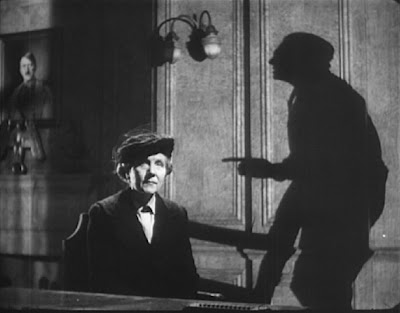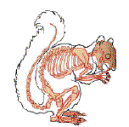 Charles McGraw and William Conrad in The Killers (dir. Robert Siodmak, 1946).
Charles McGraw and William Conrad in The Killers (dir. Robert Siodmak, 1946). Virginia Christine, Burt Lancaster, and Ava Gardner.
Virginia Christine, Burt Lancaster, and Ava Gardner. Burt Lancaster and Vince Barnett.Ernest Hemingway's 1927 short story "The Killers"
Burt Lancaster and Vince Barnett.Ernest Hemingway's 1927 short story "The Killers" is structured around three intrusions upon the young Nick Adams' moral innocence. Each intrusion comes in the form of a display by others of emotional detachment from matters of life and death. First there are the two killers, who saunter casually into a lunch room and announce their intentions of killing a "Swede" as nonchalantly as though they were planning a fishing trip. They take cold pleasure in bullying and berating Nick, George the counterman, and Sam the "nigger cook," tying Nick and Sam up and stashing them in the kitchen. When they decide the Swede isn't showing up, they leave without further incident. Next there is Ole Anderson, the Swede himself. When Nick shows up at his hotel room to warn him, Ole declines all offers of help and shows little inclination to protect himself. He appears to have determined that his fate is sealed and there is nothing to be done about it. Finally, when Nick tells George about Ole's response and says that he "can’t stand to think about him waiting in the room and knowing he’s going to get it," George delivers the last line of the story: "You better not think about it." The killers have no compunctions about taking a life, Ole is seemingly apathetic about his own impending death, and George not only manages not to think about it when others kill and are killed but consciously articulates and recommends such a stance. The story's force lies in the brutal terseness with which it presents these positions to Nick, offering neither commentary nor resolution, making him (and not so much the Swede) the protagonist.
How does this provide the basis for a full-length feature film? Robert Siodmak's 1946 version starts with a faithful adaptation of Hemingway's text, leaving out only the final scene between Nick and George. From there on, an entirely new story is appended, a series of flashbacks that gradually disclose the details of Anderson (Burt Lancaster)'s past: an ill-conceived romance, a payroll heist, and an elaborate triple-cross. (The plot is very much like the plot of
Criss Cross, which Siodmak would direct three years later, again with Lancaster in the lead role.) Nick drops out of the film after the opening sequence, and as secondary protagonist--after the Swede--we get an insurance investigator played by Edmund O'Brien, who is just not quite great enough to make his part interesting, though he gives it a heroic try. Still, thanks to Lancaster, Ava Gardner, Albert Dekker, and character actors like Vince Barnett, Jack Lambert, and Jeff Corey, it's a very entertaining production. The only problem, as has been observed probably thousands of times, is that the first ten minutes are so incredibly good that anything afterwards has to be a little bit of a letdown. If Charles McGraw and William Conrad had never done anything in the movies besides their portrayals of the killers, well ... we'd be missing an awful lot of fantastic performances from a lot of classic films. But you know what I'm saying.
 Ubiytsy [The Killers] (dir. Marika Beiku, Aleksandr Gordon, and Andrei Tarkovsky, 1958).
Ubiytsy [The Killers] (dir. Marika Beiku, Aleksandr Gordon, and Andrei Tarkovsky, 1958).Tarkovsky's 19-minute 1958 student film adaptation (actually, he collaborated on it with two other students, but all of it except the scene where Nick warns Anderson about the killers is chiefly under his direction) is entirely faithful to Hemingway, but it also shows the influence of Siodmak's version and of American noir generally. It's fun to think that one can see intimations of Tarkovsky's mature style in the protracted pauses and oblique angles that show up here and there, as when a knife falls to the floor in the kitchen about a foot from Nick's face, or when the camera foregrounds a fallen can as George's feet walk away through the door, trailing exaggerated shadows. Tarkovsky plays a patron who orders a liver sandwich and whistles "Lullabye of Broadway" while he waits.
 Angie Dickinson and John Cassavetes in The Killers (dir. Don Siegel, 1964).
Angie Dickinson and John Cassavetes in The Killers (dir. Don Siegel, 1964). Norman Fell and Ronald Reagan.
Norman Fell and Ronald Reagan. Lee Marvin (sweating straight vodka).
Lee Marvin (sweating straight vodka).And then there's Don Siegel's 1964 interpretation, which was meant to be the first full-length made-for-TV movie, but was finally deemed too violent and released theatrically, with great financial success. I must have said "wow" to myself aloud about twelve times while watching this--not because it's all great (though a lot of it is), but often just because I couldn't believe what I was looking at. For example, Angie Dickinson and John Cassavetes racing go-carts against rear-projection. Or Ronald Reagan in the bleachers at a drag race, looking through binoculars, sitting next to Norman Fell. Or just Lee Marvin's crazy-ass face. Clu Gulagher is pretty damn good as the other killer, too, but Marvin is some kind of two-legged king cobra. (He showed up for his final, climactic scene several hours late, guzzling straight vodka out of a 7-Up bottle. And they shot it anyway! And it is so, so great.) Siegel's big innovations are 1) to pare away all the Hemingway material leaving only the raw story idea, 2) to adopt plot elements from Siodmak's version, but changing everybody's names and making the Swede character not a Swede and not a boxer but a racecar driver, and 3) to make the killers into the "investigating" parties who unravel their mark's past. This stroke of genius, whereby Marvin's character assumes the position of protagonist for one of the film's two time-frames, transforms the somewhat weak device of O'Brien's insurance investigator into a startling narrative element that extends the unsettling moral effect visited upon Nick (and the reader) in Hemingway's story into the added material from Siodmak's film. Siodmak's is still probably the more fully realized piece of cinema, but Siegel's provocatively expands upon its vision, even if some of what it abandons of Hemingway's vision is ultimately felt as a loss.




































